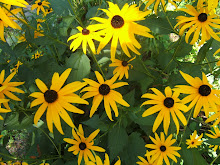
Every now and again the plant breeders come out with a plant that is so good that it stays popular for years. Stella D'oro daylily is one of those plants. It is one of the first daylilies to bloom in the summer and it blooms almost all summer long. At a tidy 2' high, it fits into any garden. Totally trouble-free - I have it in both dry and wet conditions. Super easy to divide although it doesn't have to be divided if you don't feel like it.

This is coreopsis Early Sunrise. I started it from seed last year but I have seen it sold as plants. It's planted in a dry area and seems quite happy there. The flowers are very vibrant. I think I'll grow some more next year. It's about 18" tall, so it's a relatively small plant. Not at all invasive.

The evening primrose, on the other hand, is very pushy, but I love the lemon coloured flowers. I have it planted in a dry spot with poor soil mixed in with sedum Autumn Joy, and in a situation like that it's quite controllable. I also planted some between our trees and the road where I am establishing a garden full of stalwart plants that are able to muscle out the cow parsley, thistles and any other weeds I don't want around.

This is a cousin of Stella D'Oro called Black-Eyed Stella, although it should really be orange-eyed Stella. It's just as reliable as the all yellow variety, but it grows a bit taller. For some reason, it's not as readily available but it's also a very good rebloomer that starts blooming early in the season. It's actually more orangey than the photo makes it appear.
We watched a travel show filmed in 2010 with Samantha Brown. She was travelling to different Asian countries, and I found it most encouraging to see how well Viet Nam and Cambodia are doing. The cities were much more prosperous than I would have expected and in the rural areas farming was well underway. There were, of course, areas of poverty but , as someone whose main images of those countries date back to the Viet Nam war era, I was pleasantly surprised by how well the countries devastated by that war are doing. People really are resilient.
 The Blue Clips campanula (campanula carpatica), which is also available in White Clips, is one of my favourite plants. It grows into a mound no more than about 8" high but given good soil, adequate moisture and at least half day sun, it will have lots of blooms over many weeks. It's hardy to zone 4 but I have lost some plants if the spring or fall is overly wet. Not a problem as they are readily available in the spring at garden centers for a modest price. Many seed catalogues also offer the seeds and they are pretty easy to get going and will bloom the first year after seeding if you get them started early enough. They make a great front of the border edging plant.
The Blue Clips campanula (campanula carpatica), which is also available in White Clips, is one of my favourite plants. It grows into a mound no more than about 8" high but given good soil, adequate moisture and at least half day sun, it will have lots of blooms over many weeks. It's hardy to zone 4 but I have lost some plants if the spring or fall is overly wet. Not a problem as they are readily available in the spring at garden centers for a modest price. Many seed catalogues also offer the seeds and they are pretty easy to get going and will bloom the first year after seeding if you get them started early enough. They make a great front of the border edging plant. I haven't seen the peach leaf campanula (campanula persicifolia) at the local nurseries. I bought mine from Rockwood Gardens through the mail a couple of years ago. I'm really happy with it. It is a spreader but I have it where it has room to spread. I haven't watered it all summer and even though we've hardly had a drop of rain all July, it is doing just fine. It blooms in June but still has the odd flower now. The flowers come out along the stem which grows to about 2' high. It doesn't flop over because the stems are very stiff. It's a lovely mauve colour and I have paired it with a scabiosa of similar colour. Definitely hardy to zone 4. It enjoys lots of sun.
I haven't seen the peach leaf campanula (campanula persicifolia) at the local nurseries. I bought mine from Rockwood Gardens through the mail a couple of years ago. I'm really happy with it. It is a spreader but I have it where it has room to spread. I haven't watered it all summer and even though we've hardly had a drop of rain all July, it is doing just fine. It blooms in June but still has the odd flower now. The flowers come out along the stem which grows to about 2' high. It doesn't flop over because the stems are very stiff. It's a lovely mauve colour and I have paired it with a scabiosa of similar colour. Definitely hardy to zone 4. It enjoys lots of sun.








